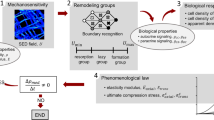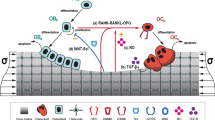Abstract
The control mechanism of mechanical bone remodeling at cellular level was investigated by means of an extensive parametric study on a theoretical model described in this paper. From a perspective of control mechanism, it was found that there are several control mechanisms working simultaneously in bone remodeling which is a complex process. Typically, an extensive parametric study was carried out for investigating model parameter space related to cell differentiation and apoptosis which can describe the fundamental cell lineage behaviors. After analyzing all the combinations of 728 permutations in six model parameters, we have identified a small number of parameter combinations that can lead to physiologically realistic responses which are similar to theoretically idealized physiological responses. The results presented in the work enhanced our understanding on mechanical bone remodeling and the identified control mechanisms can help researchers to develop combined pharmacological–mechanical therapies to treat bone loss diseases such as osteoporosis.
Similar content being viewed by others
References
Robling A.G., Castillo A.B., Turner C.H.: Biomechanical and molecular regulation of bone remodeling. Annu. Rev. 8, 455–498 (2006)
Frost H.M.: Intermediary Organization of the Skeleton. CRC Press, Boca Raton (1986)
Moroz A., Crane M.C., Smith G., Wimpenny D.I.: Phenomenological model of bone remodeling cycle containing osteocyte regulation loop. Biosystems 84, 183–190 (2006)
Nijweide P.J., Burger E.H., Klein-Nulend J.: The Osteocyte. Academic Press, San Diego (2002)
Knothe Tate M.L., Steck R., Forwood M.R., Niederer P.: In vivo demonstration of load-induced fluid flow in the rat tibia and its potential implications for processes associated with functional adaptation. J. Exp. Biol. 203, 2737–2745 (2000)
Weinbaum S., Cowin S.C., Zeng Y.: A model for the excitation of osteocytes by mechanical loading-induced bone fluid shear stresses. J. Biomech. 27, 339–360 (1994)
Klein-Nulend J., Bacabac R.G., Mullender M.G.: Mechanobiology of bone tissue. Pathol. Biol. 53, 576–580 (2005)
Bakker A.D., Soejima K., Klein-Nulend J., Burger E.H.: The production of nitric oxide and prostaglandin E2 by primary bone cells is shear stress dependent. J. Biomech. 34, 671–677 (2001)
Bacabac R.G., Smit T.H., Mullender M.G., Dijcks S.J., Loon J.J.V., Klein-Nulend J.: Nitric oxide production by bone cells is fluid shear stress rate dependent. Biochem. Biophys. Res. Commun. 315, 823–829 (2004)
Mullender M., El Haj A., Yang Y., van Duin M., Burger E., Klein-Nulend J.: Mechanotransduction of bone cellsin vitro: mechanobiology of bone tissue. Med. Biol. Eng. Comput. 42, 14–21 (2004)
Ajubi N.E., Klein-Nulend J., Nijweide P.J., Vrijheid-Lammers T., Alblas M.J., Burger E.H.: Pulsating fluid flow increases prostaglandin production by cultured chicken osteocytes-a cytoskeleton-dependent process. Biochem. Biophys. Res. Commun. 225, 62–68 (1996)
Ajubi N.E., Klein-Nulend J., Alblas M.J., Burger E.H., Nijweide P.J.: Signal transduction pathways involved in fluid flow-induced PGE2 production by cultured osteocytes. Am. J. Physiol. Endocrinol. Metab. 276, E171–E178 (1999)
Burger E.H., Klein-Nulend J.: Mechanotransduction in bone-role of the lacuno-canalicular network. FASEB J. 13, 101–112 (1999)
Chambers T.J., Fox S., Jagger C.J., Lean J.M., Chow J.W.M.: The role of prostaglandins and nitric oxide in the response of bone to mechanical forces. Osteoarthr. Cartil. 7, 422–423 (1999)
Bakker A., Klein-Nulend J., Burger E.: Mechanotransduction in bone cells proceeds via activation of COX-2, but not COX-1. Biochem. Biophys. Res. Commun. 305, 677–683 (2003)
Joldersma M., Klein-Nulend J., Oleksik A.M., Heyligers I.C., Burger E.H.: Estrogen enhances mechanical stress-induced prostaglandin production by bone cells from elderly women. Am. J. Physiol. Endocrinol. Metab. 280, E436–E442 (2001)
Klein-Nulend J., Sterck J.G.H., Sterck J.G.H., Semeins C.M., Lips P., Joldersma M., Baart J.A., Burger E.H.: Donor age and mechanosensitivity of human bone cells. Osteoporosis Int. 13, 137–146 (2002)
Wang F.S., Wang C.J., Chen Y.J., Huang Y.T., Huang H.C., Chang P.R., Sun Y.C., Yang K.D.: Nitric oxide donor increases osteoprotegerin production and osteoclastogenesis inhibitory activity in bone marrow stromal cells from ovariectomized rats. Endocrinology 145, 2148–2156 (2004)
Burger E.H., Klein-Nulend J., Smit T.H.: Strain-derived canalicular fluid flow regulates osteoclast activity in a remodelling osteon-proposal. J. Biomech. 36, 1453–1459 (2003)
van’T Hof R.J., Ralston S.H.: Nitric oxide and bone. Immunology 103, 255–261 (2001)
Fan X., Roy E., Zhu L., Murphy T.C., Ackert-Bicknell C., Hart C.M., Rosen C., Nanes M.S., Rubin J.: Nitric oxide regulates receptor activator of nuclear factor-{kappa}B ligand and osteoprotegerin expression in bone marrow stromal cells. Endocrinology 145, 751–759 (2004)
Machwate M., Harada S., Leu C.T., Seedor G., Labelle M., Gallant M., Hutchins S., Lachance N., Sawyer N., Slipetz D., Metters K.M., Rodan S.B., Young R., Rodan G.A.: Prostaglandin receptor EP4 mediates the bone anabolic effects of PGE2. Mol. Pharmacol. 60, 36–41 (2001)
Keila S., Kelner A., Weinreb M.: Systemic prostaglandin E2 increases cancellous bone formation and mass in aging rats and stimulates their bone marrow osteogenic capacity in vivo and in vitro. J. Endocrinol. 168, 131–139 (2001)
Raisz L.G.: Physiology and pathophysiology of bone remodeling. Clin. Chem. 45, 1353–1358 (1999)
Mullender M.G., Huiskes R., Weinans H.: A physiological approach to the simulation of bone remodeling as a self organization control process. J. Biomech. 27, 1389–1394 (1994)
Huiskes R., Ruimerman R., van Lenthe G.H., Janssen J.D.: Effects of mechanical forces on maintenance and adaptation of form in trabecular bone. Nature 405, 704–706 (2000)
Ruimerman R., Huiskes R., van Lenthe G.H., Janssen J.D.: A computer-simulation model relating bone-cell metabolism to mechanical adaptation of trabecular architecture. Comput Methods Biomech. Biomed. Eng. 4, 433–448 (2001)
Ruimerman R., Hilbers P., van Rietbergen B., Huiskes R.: A theoretical framework for strain-related trabecular bone maintenance and adaptation. J. Biomech. 38, 931–941 (2005)
Ruimerman, R.: Modeling and remodeling in bone tissue. Technische Universiteit Eindhoven, Eindhoven. http://alexandria.tue.nl/extra2/200510655.pdf (2005)
Weinans H., Huiskes R., Grootenboer H.J.: The behavior of adaptive bone-remodeling simulation models. J. Biomech. 25, 1425–1441 (1992)
Li J., Li H., Shi L., Fok A.S.L., Ucer C., Devlin H., Horner K., Silikas N.: A mathematical model for simulating the bone remodeling process under mechanical stimulus. Dent. Mater. 23, 1073–1078 (2007)
Alon U.: An Introduction to Systems Biology: Design Principles of Biological Circuits. CRC Press, New York (2007)
Pivonka P., Zimak J., Smith D.W., Gardiner B.S., Dunstan C.R., Sims N.A., John Martin T., Mundy G.R.: Model structure and control of bone remodeling: a theoretical study. Bone 43, 249–263 (2008)
Robling A.G., Hinant F.M., Burr D.B., Turner C.H.: Improved bone structure and strength after long-term mechanical loading is greatest if loading is separated into short bouts. J. Bone Miner. Res. 17, 1545–1554 (2002)
Rubin C., Turner A.S., Bain S., Mallinckrodt C., McLeod K.: Anabolism. Low mechanical signals strengthen long bones. Nature 412, 603–604 (2001)
Bergmann, G., Graichen, F., Rohlmann, A.: Hip joint force measurements.http://www.medizin.fu-berlin.de/biomechanik/homefrme.htm (2003)
Parfitt A.M.: Osteonal and hemi-osteonal remodeling: the spatial and temporal framework for signal traffic in adult human bone. J. Cell. Biochem. 55, 273–286 (1994)
Author information
Authors and Affiliations
Corresponding author
Rights and permissions
About this article
Cite this article
Wang, Y., Qin, QH. Parametric study of control mechanism of cortical bone remodeling under mechanical stimulus. Acta Mech Sin 26, 37–44 (2010). https://doi.org/10.1007/s10409-009-0313-z
Received:
Accepted:
Published:
Issue Date:
DOI: https://doi.org/10.1007/s10409-009-0313-z




